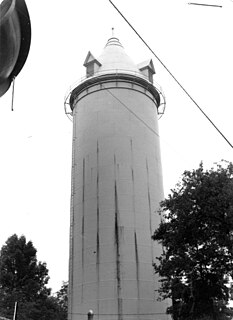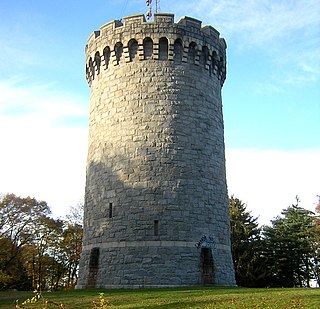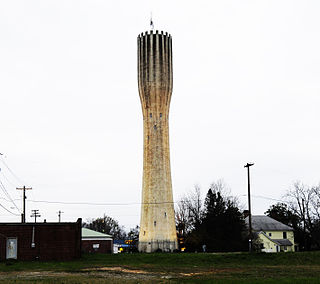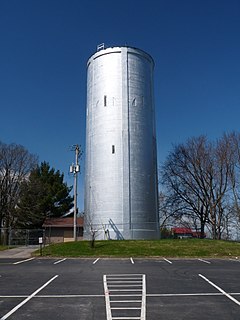
Eden Park Standpipe is an ornate historic standpipe standing on the high ground of Eden Park in Cincinnati, Ohio. The standpipe is a form of water tower common the late 19th century. It was listed in the National Register on March 3, 1980.

The Eden Park Station No. 7 is a historic structure located in Eden Park in Cincinnati, Ohio, United States. Constructed in the late nineteenth century as a significant part of the city water supply system, it was used for its original purpose for only a few decades. As a work of Cincinnati's most important architect, it has been named a historic site.

Bellevue Standpipe is a historic water storage tank on Bellevue Hill at Washington Street and West Roxbury Parkway in the Stony Brook Reservation of Boston, Massachusetts. Built in 1914, it is one of three early 20th-century water tanks built as part of Greater Boston's public water supply. The structure was added to the National Register of Historic Places in 1990.

Roxbury High Fort is a historic fort site on Beech Glen Street at Fort Avenue in the Roxbury neighborhood of Boston, Massachusetts. The site now contains a small park and the Cochituate Standpipe, also known as Fort Hill Tower, built in 1869. The fort site was added to the National Register of Historic Places in 1973. The site inspired the name of the Fort Hill neighborhood, which surrounds the area of the High Fort.

Compton Hill Reservoir Park is a 36-acre (15 ha) public park located in the Compton Heights neighborhood of St. Louis, Missouri, USA. Located on one of the highest elevations within the city, the park surrounds a 28-million-US-gallon (110,000 m3) reservoir used to provide water for many of the city's residents.

Fall River Waterworks is a 22-acre (8.9 ha) historic site located at the eastern end Bedford Street in Fall River, Massachusetts, along the shore of North Watuppa Pond. The property, which is still used as a water works for the city, contains the original pumping station, intake house and 121-foot (37 m) tall standpipe water tower. The system was originally built between 1872 and 1875, and expanded or upgraded many times. It was added to the National Register of Historic Places in 1981.

The High Service Water Tower and Reservoir, colloquially known as the Tower Hill Tower, is a public water supply facility off Massachusetts Route 110 in Lawrence, Massachusetts. The reservoir was constructed in 1874-75 to provide the city's public water supply, with a gatehouse designed by Charles T. Emerson, a Lawrence architect. The tower was built in 1896 as a high pressure standpipe or water tower. The tower stands 157 feet (48 m) high, and is built out of red brick with granite trim. It is Romanesque in its style, and was designed by George G. Adams, a noted local architect who had been taught by Emerson. The standpipe inside the tower is of steel construction and is 102 feet (31 m) in height. The area above the standpipe includes a balcony capped by a chateauesque roof, with round-arch windows providing views of the area. The main tower is octagonal in shape, with a narrow round staircase tower projection from one side.

The Reading Standpipe was a historic water tower atop a hill near the corner of Auburn and Beacon Streets in Reading, Massachusetts. The 138-foot (42 m) tower was built in 1890-91 as part of Reading's first water supply system, and was for many years a significant community landmark. The tower was built of steel and wrought iron in a style reminiscent of medieval fortifications.

The Forbes Hill Standpipe is a historic water tower structure located on Reservoir Road in Quincy, Massachusetts, USA. The tower was built in 1899-1902 to contain a 330,000 US gallons steel water tank. The site originally included an adjacent reservoir that supplied the Quincy with water from the Metropolitan Boston Water System. The standpipe was taken out of service in 1955 and the reservoir was filled in.

The Arlington Reservoir is a large water storage tank located on Park Circle in Arlington, Massachusetts. It was constructed by the Metropolitan Water Works between 1921 and 1924 in the Classical Revival style, to provide water storage for Northern Extra-High Service area, consisting of Lexington and the higher elevations of Belmont and Arlington.

The Grand Avenue Water Tower is a water tower located at the intersection of Grand Avenue and 20th street in the College Hill neighborhood of St. Louis, Missouri. It is the oldest extant water tower in St. Louis, pre-dating both the Bissell Street Water Tower and the Compton Hill Water Tower.

Bissell Street Water Tower is a historic standpipe water tower located at the junction of Bissell Street and Blair Avenue in St. Louis, Missouri. The tower was completed in 1886 and was in service until 1912. It is one of three remaining historic standpipes in Saint Louis, along with the Grand Avenue Water Tower and the Compton Hill Water Tower.

The Pittsburgh-Des Moines Steel Company, and often referred to as Pitt-Des Moines Steel or PDM was an American steel fabrication company. It operated from 1892 until approximately 2002 when its assets were sold to other companies, including Chicago Bridge & Iron Company. The company began as a builder of steel water tanks and bridges. It also later fabricated the "forked" columns for the World Trade Center in the 1960s, and was the steel fabricator and erector for the Gateway Arch in St. Louis. A number of its works are listed on the National Register of Historic Places.

The Belton Standpipe, in Belton, South Carolina, historically known as the Belton Waterworks Tower, is a 155-foot high concrete water tower located near the downtown area. Construction on the tower began in 1908 and was completed in 1909. It is the tallest of three standpipe water towers in the state.

The Evansville Standpipe is a historic water tower located in Evansville, Wisconsin. The 80-ft tall steel tower was built in 1901 by the Chicago Bridge & Iron Company, as part of the development of the local water supply system, spurred on by a devastating fire in 1896 that destroyed a large section of downtown Evansville. It was added to the National Register of Historic Places in 2008.

The Lake City Water Standpipe is a historic structure located in Lake City, Iowa, United States. The standpipe was a popular form of water tower from about 1860 to the turn of the 20th-century. The city council first attempted to build it as early as 1890, but the $10,000 bond was rejected. An $8,000 bond issue passed in June 1893, and a Water Works Department was established. The city contracted with the A.F. Paige Company of Sioux City to build the tower, which is 90 feet (27 m) tall and a diameter of 12 feet (4 m). It was completed in November 1893. Water mains were laid the following year and water was delivered to most citizens of Lake City. It also allowed the city to provide adequate fire protection. A new water tank was built next to the standpipe in the 1920s. It has subsequently been replaced by a larger structure on the southeast side of town. The standpipe was listed on the National Register of Historic Places in 1990.

Bremen Water Tower, also known as Bremen Water Works Standpipe, is a historic water tower located at Bremen, Marshall County, Indiana. It was built in 1892, and consists of a 68 foot tall brick base with Second Gothic Revival style design elements topped by a 36 foot tall tank. The base sits on a limestone foundation and is 13 feet in diameter. It was taken out of commission in 1955. It remains a community icon and was named an American Historic Water Landmark in 1975.

The Manning Water Tower is a historic structure located in Manning, Iowa, United States. It is significant as a good example of early 20th-century steel elevated water tower design, and its association with Anson Marston and the Chicago Bridge & Iron Company. Marston, who designed the structure, was a professor of engineering at Iowa State College. Manning native Henry J. Brunnier, who studied under Marston, convinced the city council to use one of Marston's designs rather than a less expensive standpipe. He also assisted with this water tower's design, and went on to career as a civil engineer in San Francisco. Also involved in the tower's design was the Chicago Bridge & Iron Company, who built it in 1903. It replaced a pump house with a steam-powered engine and a large water tank that was built near the town's well in 1894. The water tower is 140.75 feet (42.90 m) tall. It has a 60,000-US-gallon (230 kl) steel tank, with a cast-iron center pipe, and four steel legs. The superstructure rests on concrete piers with limestone capstones, and the tank is capped with a pagoda-shaped roof. The water tower was listed on the National Register of Historic Places in 2016.

The Harper Standpipe is a standpipe built during 1886–87 in Harper, Kansas. It was listed on the National Register of Historic Places in 2017.

The Neillsville Standpipe is located in Neillsville, Wisconsin.





















